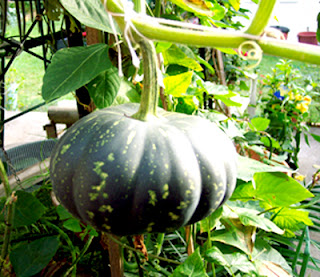Health Benefits of Pumpkin
 |
| pumpkin |
pumpkin
Benefits of Pumpkin - Green and orange are some of the colors pumpkin. These delicious additions to your diet not only provide a wide range of nutritional benefits of pumpkin, but are an example of being able to eat seasonally and locally. Another plus is that they can be stored without refrigeration for long periods of time.
When it comes to pumpkin nutrition, these vegetables have a lot in common. Because benefits of pumpkin their orange color, they are full of beta carotene. This nutrient has health benefits of pumpkin, but can turn into vitamin A as needed by the body. These nutrients benefits of pumpkin are important for eye and skin health, as well as for many other body tissues. They also play a role in the immune system.
Orange vegetables contain many other antioxidants, such as lutein, zeaxanthin, and alpha carotene that help protect the body from free radicals (a cause of tissue damage). These and other nutrients found in the orange vegetables fall under the heading of "phytonutrients" —— nutrients found in plant foods that contribute to optimal health that we are just beginning to learn about.
The antioxidants in these vegetables have the potential to health benefits of pumpkin conditions such as reduced risk of some cancers. They are important for growth, development and health in babies and children/teens. For adults, they contribute to overall health and reduced risk of tissue breakdown.
Vitamin C, K, E and several B vitamins are also found in orange vegetables, as are many minerals — potassium, iron, magnesium, manganese and copper. These nutrients of pumpkin have many jobs in the body.
 |
| yellow pumpkin |
yellow pumpkin
Health Benefits of Pumpkins
 |
| green pumpkin |
green pumpkin
Benefits of pumpkins are great sources of fiber, as well. Higher fiber intakes can help lower cholesterol numbers and assist with blood pressure and blood sugar regulation. Fiber can also help with weight control because it adds bulk at a meal, meaning we feel fuller and overall may eat less. It also slows digestion so the fuel from a meal or snack lasts longer and we may feel the need to eat less often.
The Dietary Guidelines for Americans 2010 recommends that adults consume four to seven cups of pumpkin a week (depending on the total amount of calories consumed). With regard to the new "My Plate" that has replaced the Food Pyramid, including more of these vegetables can help you to reach the goal of making half your plate veggies. Think back about your food intake this past week. How did you do with these pumpkin nutrient
If you are a little behind in achieving the recommendations, browse through the produce section this week and choose a few of these golden veggies to take home. Numerous recipes are available online. Because of their sweet (and in some cases nutty) flavor, they blend well with both sweet and savory foods.
All can be baked or steamed — whole, bite-sized, or mashed. Bite-sized pieces can be tossed with a little olive oil (maybe with a sprinkle of minced fresh herbs or other seasoning) and roasted in the oven until tender.
With the colder weather, they are a sweet and hearty addition to soups, stews, and chili. Roasting them before adding them to a soup adds even more flavor. They pair well with fruit like apples in a soup or add a contrast to the hot spices — cumin, chili powder or curry — in savory dishes.
Try simmering cubes of butternut squash and carrots with water, diced tomatoes, onions, coriander, cumin, turmeric, ground ginger, and a dash of cayenne pepper in a covered pot and cook until tender. Then serve over cooked quinoa or brown rice and sprinkle with chopped fresh cilantro.
Add some pureed pumpkin or orange squash to chowder for added nutrients and a nice golden color. Slip some into a muffin batter, pancake or waffle batter, or yeast dough bread. Spices like cinnamon, ginger, nutmeg, allspice and cloves can be added as well. Another option is to add pureed carrot, squash or pumpkin to tomato sauce and serve over whole grain pasta.
For dessert, try a pumpkin or winter squash custard — like pumpkin pie without the crust. This provides the nutrients from the orange vegetables and milk while cutting down on the fat and calories. Try using low fat milk or low fat evaporated milk and reduce the sugar to save even more calories. A pumpkin cheesecake is another seasonal dessert that can be made with fat-free cream cheese and less sugar to lower the calorie count.
Title : Benefits of Pumpkin
Description : Health Benefits of Pumpkin pumpkin pumpkin Benefits of Pumpkin - Green and orange are some of the colors pumpkin. These deliciou...
Description : Health Benefits of Pumpkin pumpkin pumpkin Benefits of Pumpkin - Green and orange are some of the colors pumpkin. These deliciou...
